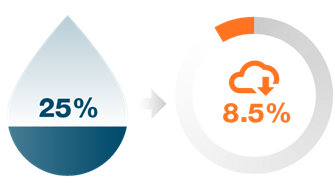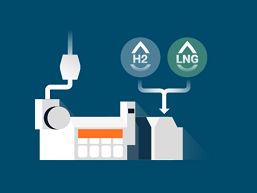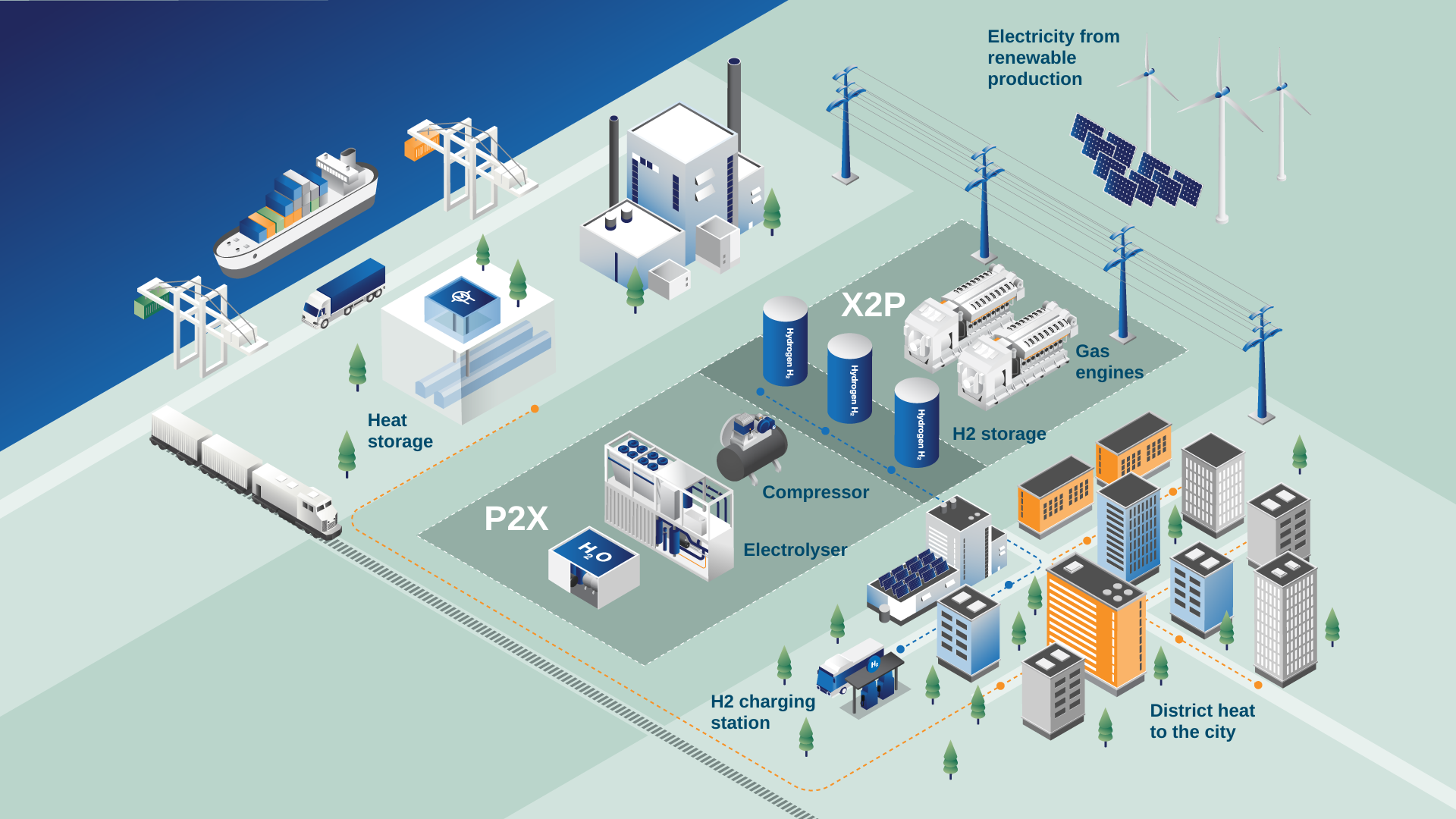
How to use hydrogen in power generation?
At the moment, hydrogen is the most promising candidate of the P2X fuel for power plants. Hydrogen is carbon-free, has the highest production energy efficiency of the P2X fuels and with time it is predicted to become the most cost competitive due to low renewable electricity prices. Of course, there are several issues still to be tackled.
Important for green hydrogen production is access to renewable electricity and clean water. Locations with favourable conditions for these will become hydrogen production hubs.
For a sustainable power plant the access to the fuel will be crucial. Mode of fuel transport and distance will have a strong impact on costs and distribution emissions. Likewise, the storage volumes and capabilities need viable solutions. Hydrogen, being a gas, can be distributed via a gas grid which is the best option for both costs and distribution emissions. Hydrogen can be blended with natural gas. However, many industrial users (early adopters) prefer pure hydrogen, which pushes for dedicated hydrogen grids or on-site P2X production. One key concern with green hydrogen is how long it will take to build the needed infrastructure and ensure green hydrogen in adequate amounts.
When it comes to which fuel will be used, availability and cost are of course important, but there are other parameters to consider such as footprint of production and storage, and operational safety. A natural gas blend with up to a maximum of 25 vol% hydrogen is still considered to be natural gas and thus rules and regulations for use are already in place. With higher hydrogen blends or pure hydrogen more attention is needed on material selections and designing the overall safety of the power plant solution.

The many shades of hydrogen
Hydrogen can be produced in many ways, each one labelled with different colours:
Green hydrogen is produced through electrolysis of water utilizing renewable electricity.
Pink hydrogen is otherwise the same, but the electricity used in the electrolysis is generated by nuclear power.
Blue hydrogen is produced by splitting fossil natural gas into hydrogen and CO2 and then capturing and storing or utilising the CO2.
Grey hydrogen is created in the same way as blue hydrogen, except the carbon dioxide is not captured but released into the atmosphere. This is how the majority of hydrogen is produced today.

COMBUSTION OF A 25 VOL% HYDROGEN/NATURAL GAS BLEND CORRESPONDS TO A GREENHOUSE GAS EMISSION REDUCTION OF
8.5%
A 10 MW ENGINE WILL RUN FOR APPROXIMATELY
ONE HOUR
WITH THE CAPACITY OF THE LARGEST HYDROGEN FUEL DELIVERY TRUCK AVAILABLE

On islands and other remote locations with no space to build dedicated renewable energy for hydrogen production, or locations that are not in the vicinity of gas networks, it’s likely that other renewable energy sources will be used, such as liquid biofuels that are easy to transport and can be stored on site. Ammonia or methanol are also possible choices, especially when it comes to transportation.
During the transition period to P2X fuels, biomethane and biofuels can already be blended into their fossil twins, which takes off some of the pressure having the fuels in adequate amounts for the energy sector. As natural gas has the lowest GHG emissions of the fossil fuels it is the clear transition fuel especially as biomethane can be blended into the gas grid.
Hydrogen fuel scenarios
Wärtsilä has studied various scenarios that go beyond a 25 vol% hydrogen blend.
High hydrogen blends (>50% of energy from H2 corresponds to >78 vol% H2-natural gas blend)
In scenarios where hydrogen becomes the dominant fuel, hydrogen-compliant materials will add approximately 15% to engine costs. The power density is expected to drop to 40% and efficiency to 84% compared to natural gas. CO2-equivalent emissions (CO2eq) are reduced by 46%. As the power density drops drastically, the levelised cost of electricity (LCOE) is increased up to threefold. For obvious reasons, this scenario is not attractive, and furthermore this high hydrogen blends are not expected to be available.
Pure hydrogen
For a spark-ignited gas engine to use 100% hydrogen, modification to the fuel injection and combustion chamber is required as well as ensuring hydrogen-compliant materials. The modifications are not expected to increase plant costs by more than 30%, which is in line with the EUGINE Hydrogen-Readiness Concept. The power density is expected to be reduced to 73%. Our test results show that efficiency is expected to remain on same level as for natural gas, while CO2eq emissions will be close to zero.
Hydrogen derivatives
Scenarios have also been calculated for the liquid P2X fuels. A medium-speed W31 diesel engine running on green ammonia or methanol, with various mixing ratios, will require fossil LFO (or HVO) as a pilot fuel. Power density and mechanical efficiency are not expected to drop, but the fuel supply system will add approximately 15% to plant costs.

Case: A test platform for hydrogen blending
Wärtsilä will provide engine generating sets, which will run on a hydrogen and natural gas blend, for Keppel Offshore & Marine’s Floating Living Lab, an offshore floating testbed in Singapore. The Floating Living Lab is a floating barge with LNG bunkering facilities for harbour craft and small vessels. It will also house an embedded power generation system to power Keppel O&M’s operations, with excess electricity to be exported to the national grid or stored in onboard energy storage systems.

Wärtsilä is partnering with energy companies Vaasan Sähkö and EPV Energia to build a so-called Power-to-X-to-Power (P2X2P) system in the city of Vaasa, Finland. The system will use renewable energy to produce green hydrogen by electrolysis of water and the hydrogen will be further processed, stored and used for electricity and heat generation and road traffic applications. Energy production will take place in an engine power plant developed by Wärtsilä, using the latest technology.
Ensuring Safety when using hydrogen
While it’s true that hydrogen use requires safety measures, it’s worth remembering that any fuel does. Hydrogen molecules are very small and thus have a tendency to easily leak, but also dissolve into air. The explosive nature of concentrated hydrogen needs to be considered when designing hydrogen power plants. There is a safety-first approach when creating all power plant solutions, which for hydrogen engine solutions means:
Using welded pipes and double wall piping wherever possible
Utilising hydrogen sniffers at potential leakage points
Ensuring ventilation
Using inerting procedures for maintenance
